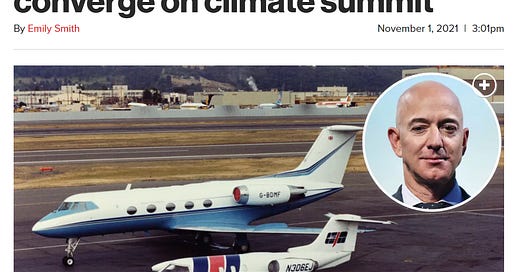On the media hype around bad weather
The disaster hysteria is meant to frighten. In reality, deaths from extreme weather events have PLUNGED over the last 50 years
I don’t want to write about climate change.
Truly. I don’t know if the models are right or wrong, and I don’t want to spend my life finding out.
But the way the media now reports on weather - not broad climate issues, but day-to-day weather - has bugged me for a while, and last night it hit (literally) close to home.
—
(STAY COOL!)
—
Climate reporting in the elite media has become a series of endless, breathlessly reported firsts and 1-in-1,000 year events. The hottest June ever in Houston. The driest August in Tokyo. The wettest April in London. The biggest wildfire in Quebec.
Oddly, one regularly finds these factoids on ESPN too: Player X is the first rookie to average 15 points, 2.2 blocks, and 1.8 steals per game since 2014. The numbers are good, but rarely as special as the framing makes them seem. They come from producers running database dives. Slice the pie thinly enough, and a decent player looks great.
Where ESPN is hoping to impress its viewers, the extreme weather statistics have a different purpose: to frighten. They’re meant to make readers believe that a climate apocalypse is upon us and that only by giving up gas stoves - not private planes, never private planes, only gas stoves - can we survive.
—
(Weather is for thee, not for meeee!)
—
Last night, a big thunderstorm hit New York’s Hudson Valley, where I live. (I wasn’t home. I was in Las Vegas to play in the World Series of Poker, where I busted out late on Day 3, a boring story I won’t tell.)
Yes, a thunderstorm in July in the Northeast. Shocker, I know.
This one was particularly slow-moving, though, and it dumped a lot of rain. Or, as the Daily News reported, “Storm in New York’s Hudson Valley kills one, brings 9 inches of rain: ‘1,000 year event.’
1000-year-event? Dear Lord Above, what have we done?
Okay, let’s look at the map.
That purple area is a huge rain dump.
But that’s not a map of the United States, or even New York, or even southern New York, or even the Hudson Valley.
That rain dump covered, wait for it, a handful of towns. For some reason a storm cell got hung up just over the Hudson River - maybe there’s a good meteorological explanation for why, maybe not. It drenched the area to the west and slightly to the east of the river with two months of rain in a few hours.
Whole lotta rain, for sure. Our house is in that blotch somewhere. I felt bad not to be home, until I got the update from my older daughter this morning: it rained, we lost power, the generator came on, the power came back on. Two of the three kids slept through it all. The end.
A 1-IN-1000 YEAR EVENT, I TELL YA!
—
But that’s just one storm. We all know that climate change is bringing death and destruction worldwide. We all know its ravages increase every year.
Except they don’t.
In 2021, the World Meteorological Organization, which is part of the United Nations, released a 90-page “Atlas of Mortality And Economic Losses From Weather, Climate, and Water Extremes.” The relevant chart is below:
—
(The worse climate change gets, the fewer people droughts and hurricanes kill:)
—
Weather-related deaths rose slightly from the 1970s through the 1980s. They have plunged 75 percent since, even though the population has nearly doubled. Over the last decade, fewer than 50 people a day died from extreme weather - on a planet that now has 8,000,000,000 people.
The explanation for this apparent contradiction is simple. Hurricanes and drought-driven famines in very poor countries drive most weather-related deaths. Wealthy and even middle-income countries can easily mitigate the effects of short-term extreme weather. To take an obvious example, anyone with a car can easily escape a hurricane, provided even a few hours notice.
And the world, as whole, is far richer than it was in 1970. At that point, 60 percent of the world’s population - 2.2 billion of the 3.7 billion people alive at the time - lived in extreme poverty, less than $450 per year. By 2016, the number had fallen to 700 million out of 7.3 billion, fewer than 10 percent.
—
Of course, energy consumption both drives and rises with economic growth.
So the question is not if climate change is real. It is if climate change hysteria, driven largely by people so wealthy that they will continue to live exactly as they do now whatever happens to the global economy, threatens to undo the economic growth that has been the most important factor reducing deaths from extreme weather.
Or we could just keep looking for 1000-year-floods to scream over.







I wish this Climate Hysteria would “bust-out” like you did‼️ (actually all-in with KQ was a good play😏)
What happens when everything turns electric and there's a power failure with a hurricane approaching? No way to escape (car isn't charged). No way to hunker down - everything in the house is powered by electric. Has no one thought of this?